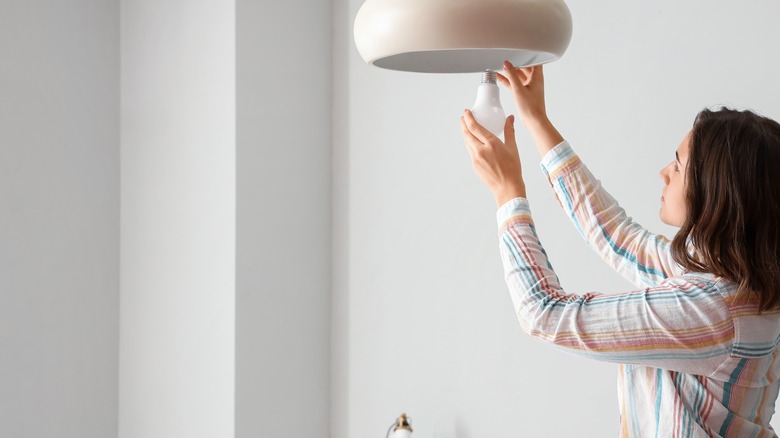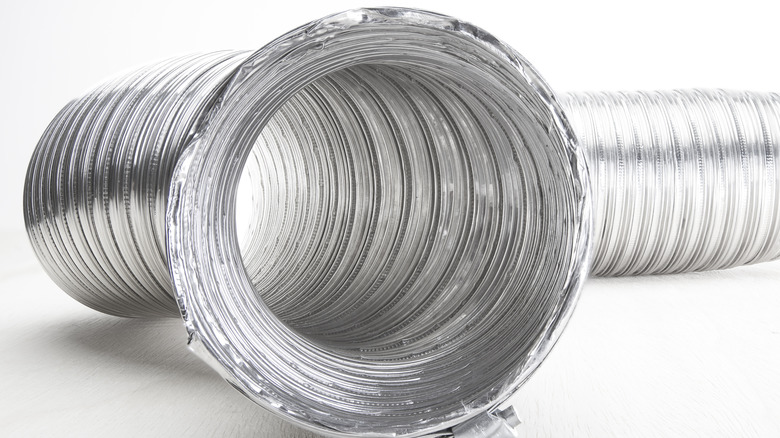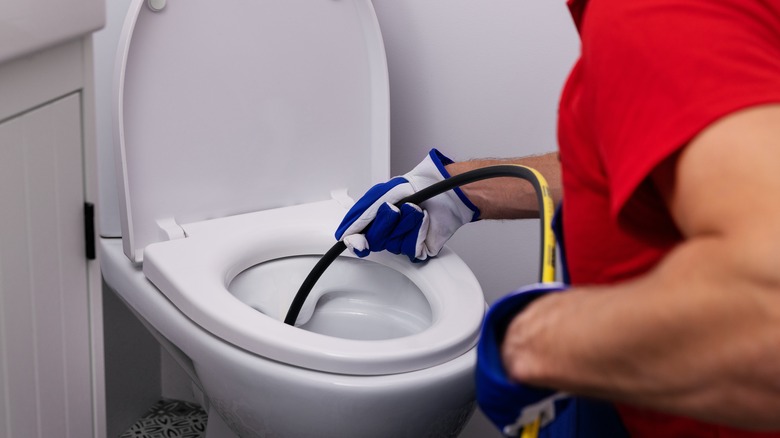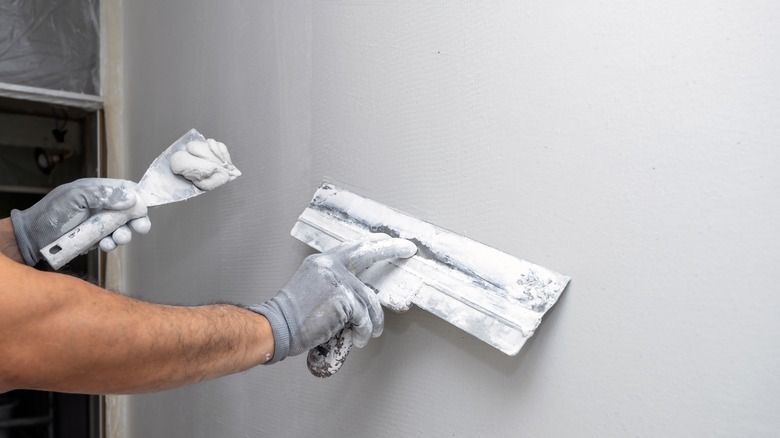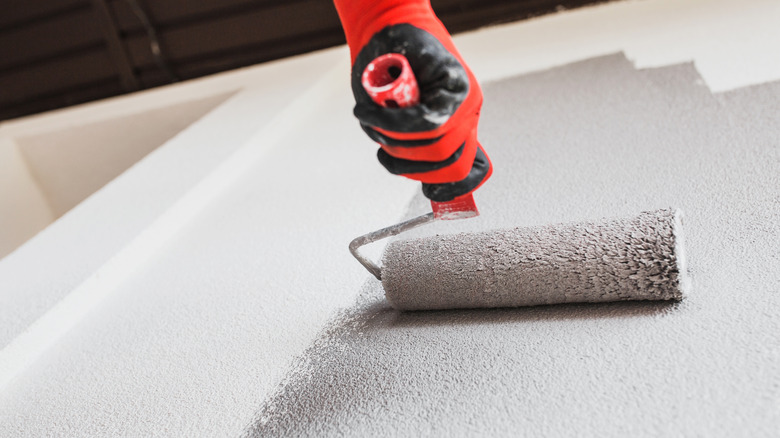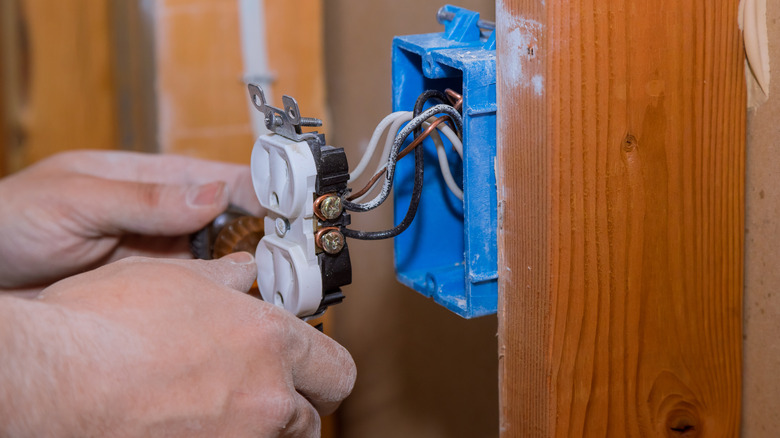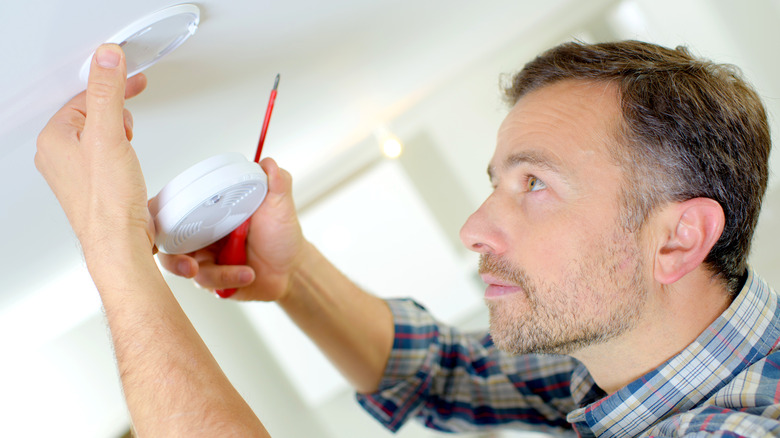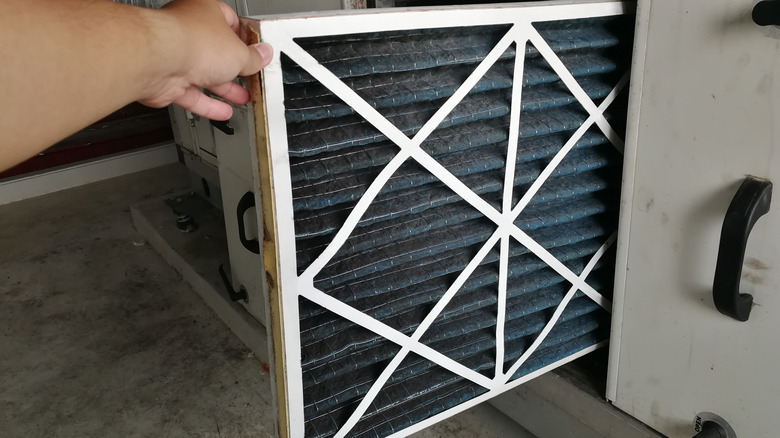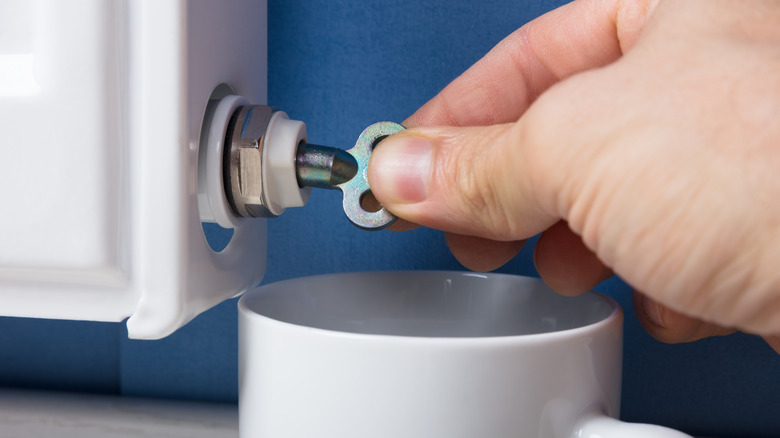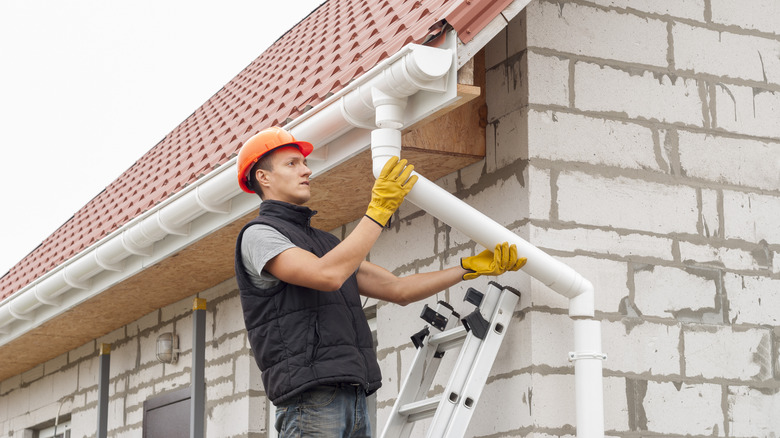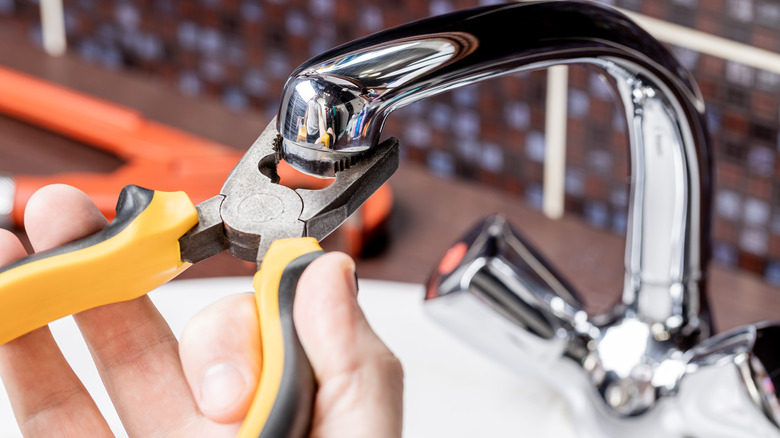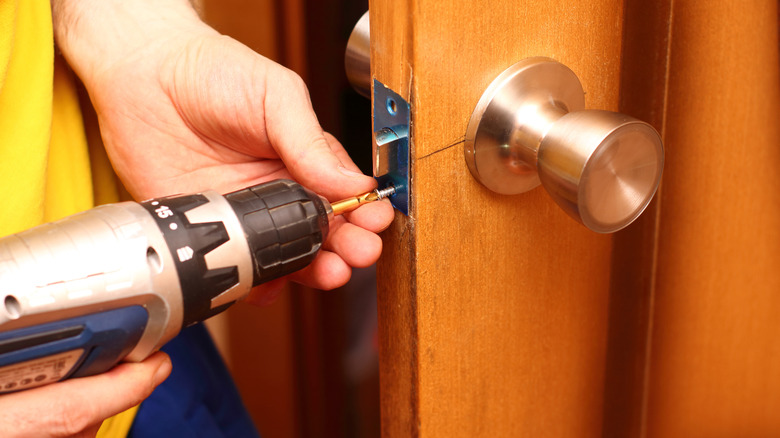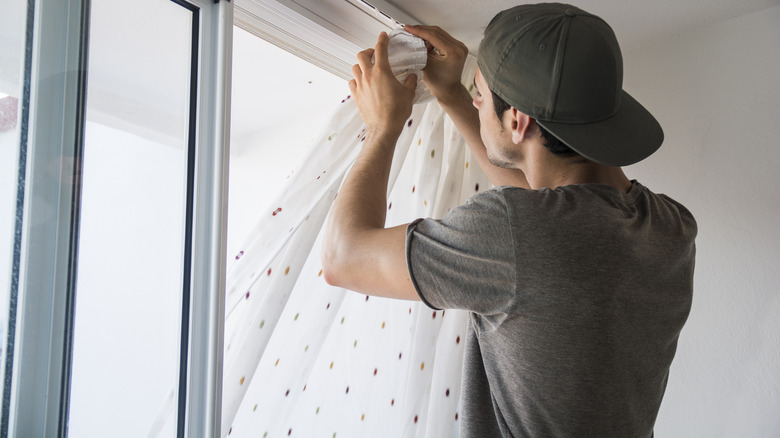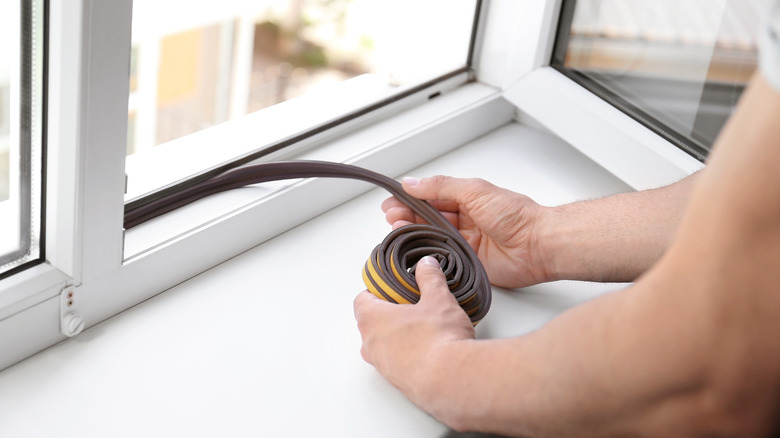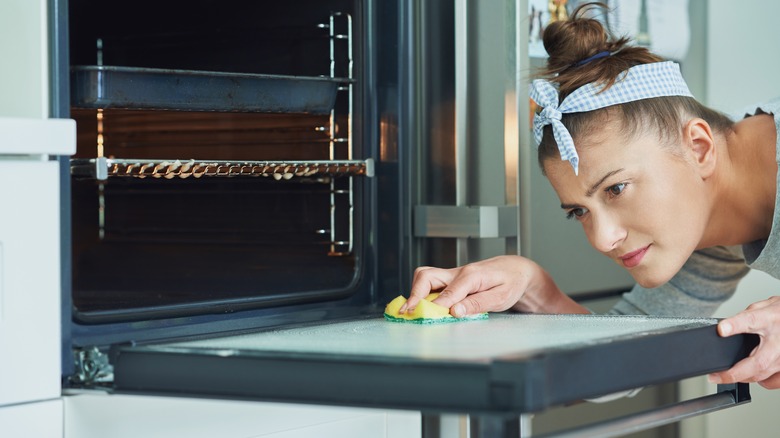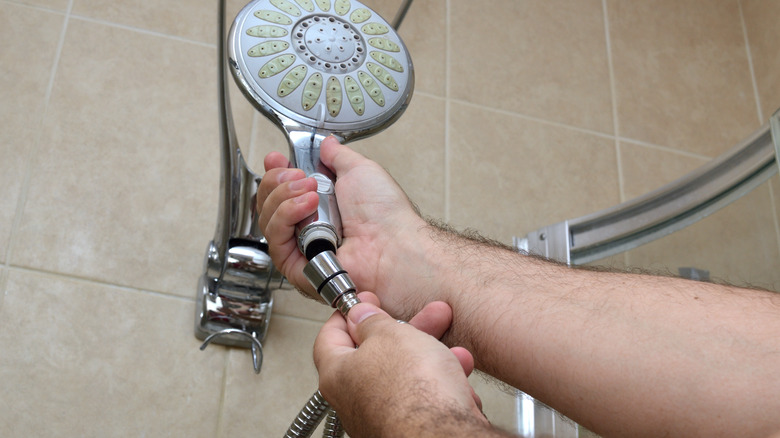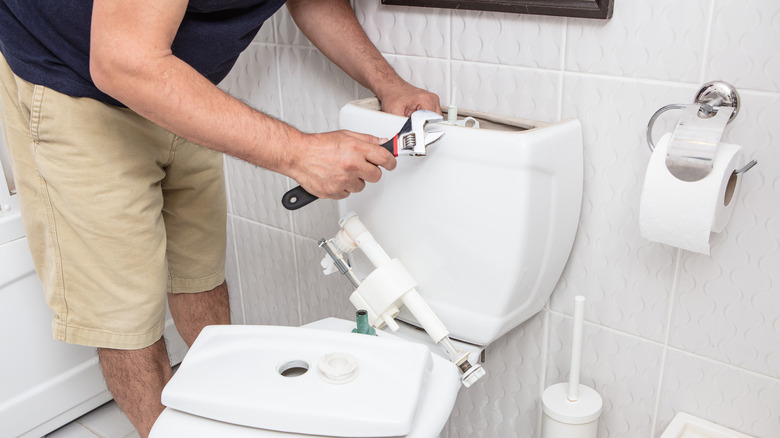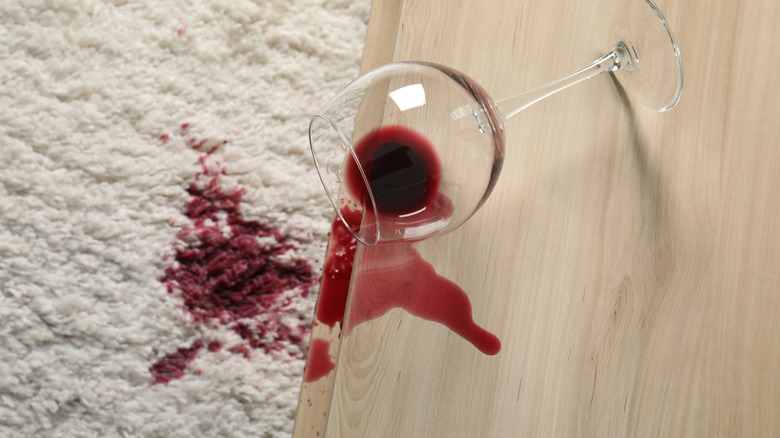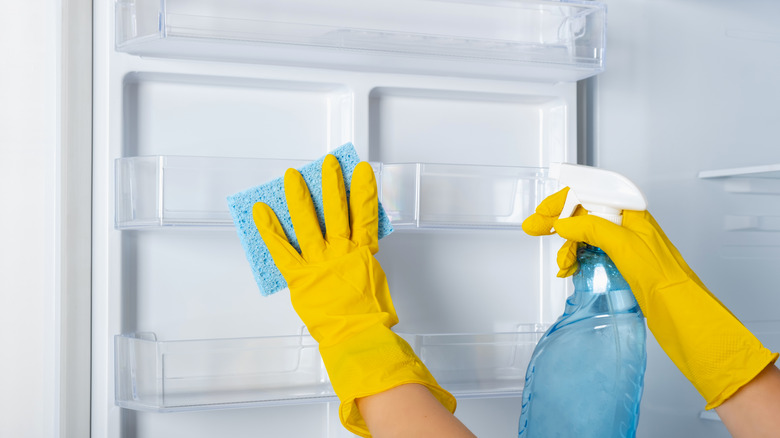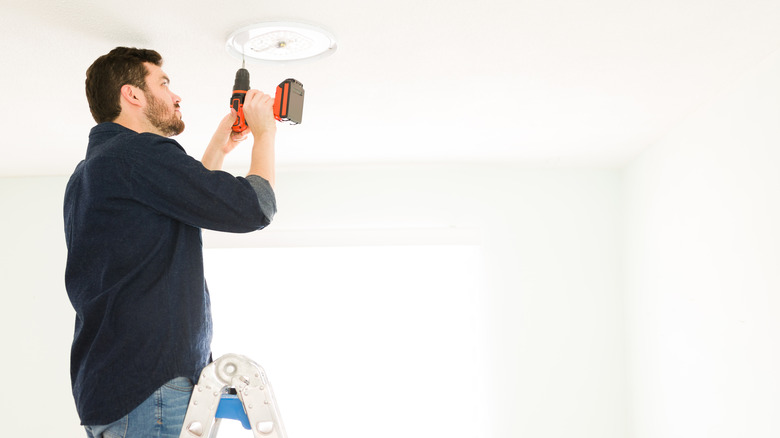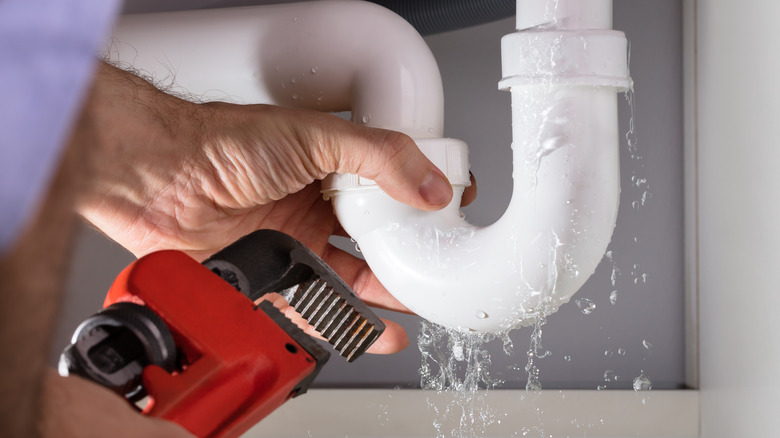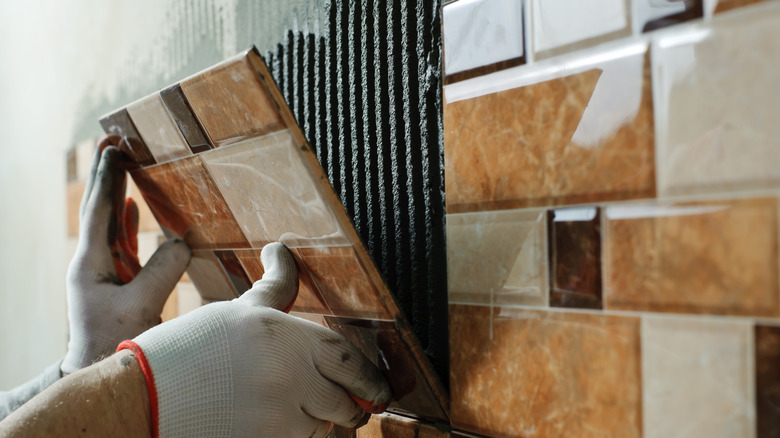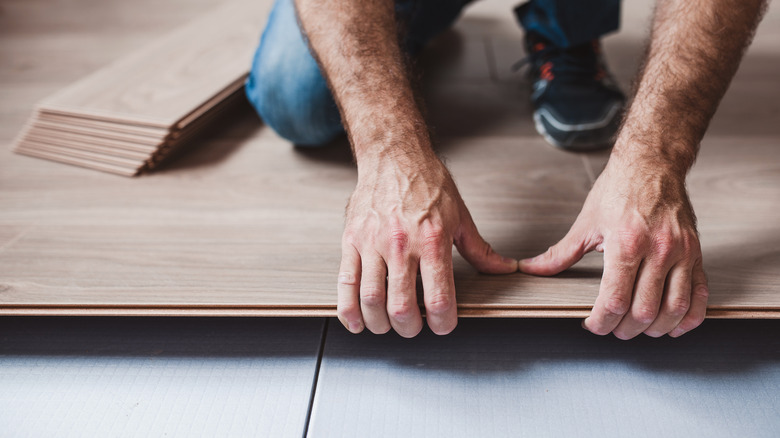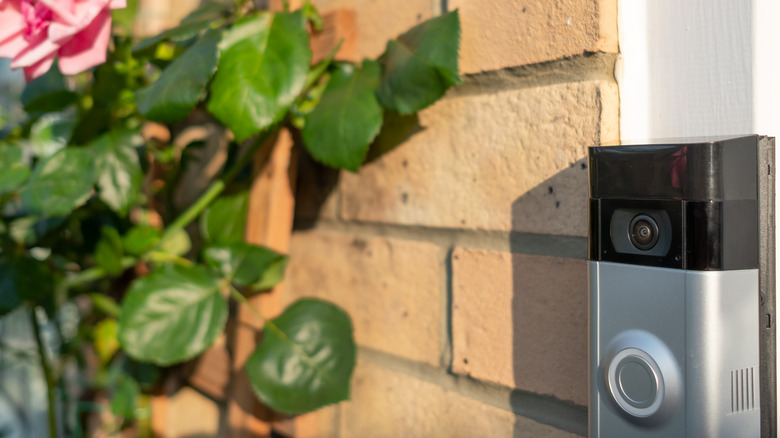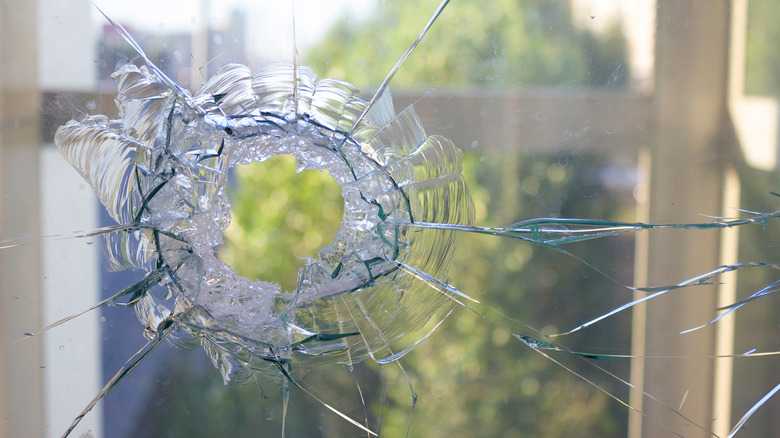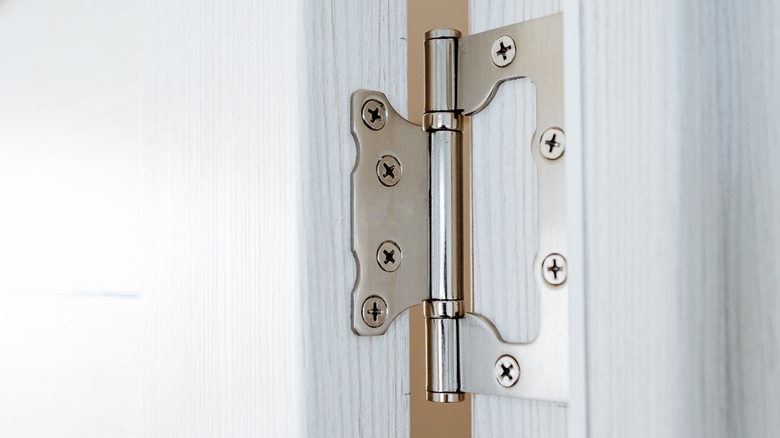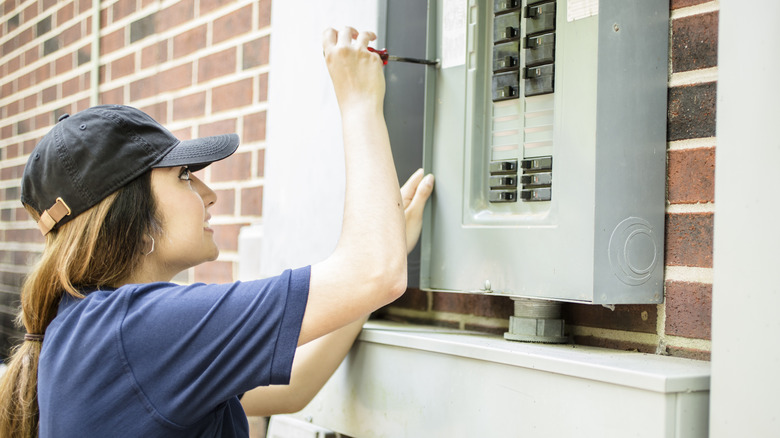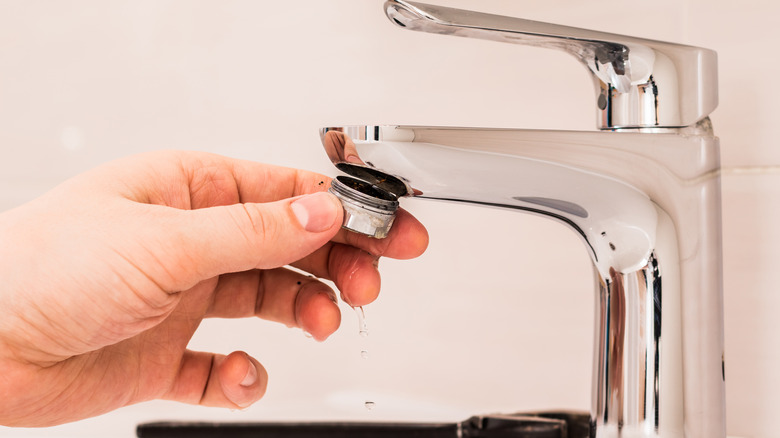30 Home Maintenance Skills To Master By The Time You Hit 30
As you enter your thirties, it is essential to develop a set of basic home maintenance skills. Knowing how to do most things around the house without needing to call in any professional backup will save you time, money, and hassle in the long run. Whether you own a home or rent, you should still have these skills, as understanding common home maintenance issues can empower you to handle issues swiftly and efficiently. If your toilet is overflowing, you won't want to wait for your landlord to show up.
From basic tasks like changing a light bulb and painting your living room to more complex ones like swapping out a broken electrical outlet and repairing a leaky faucet, these home maintenance skills are a must-know by the time you reach 30 and we'll show you why. We've also put together a guide on how to do each of them, so you can start flexing your DIY muscles (but not too hard...you are getting older, after all).
1. Changing a light bulb
By the time you're 30, you've likely encountered many a burned-out light bulb. But just in case, we will run you through the basics so you can start the new decade with this basic skill. It's simple and practical, but also kind of a safety measure as it ensures you can maintain a well-lit and functional living space.
To change a light bulb, turn off the power supply to the lamp, lighting fixture, etc. for safety. Next, let the bulb cool down if it was recently on so you don't burn your fingers. Some people prefer to pop a glove on while changing light bulbs just in case, but this is optional. Remove the old bulb by twisting it counterclockwise, and replace it with a new one, making sure it is securely screwed in. If you are worried about buying the wrong kind of replacement bulb, you can take the bulb to the store with you to get the same kind. However, most lightbulbs in the USA are A19 bulbs with E26 base.
2. Cleaning the dryer vent
This is a quick and easy task, so it's near the top of our list. If you need a quick home maintenance win, cleaning the dryer vent is for you. Regularly cleaning the dryer vent helps prevent fire hazards because the warm air from the appliance can freely escape. It also helps ensure optimal drying performance as the warm air doesn't have to fight to move around and fluff up the clothes inside. Everyone knows to clean the filter in the machine after each use, but cleaning the secondary vent is something to tackle before you turn 30.
To do so, disconnect the dryer from the power supply so you don't shock yourself. Next, move your dryer away from the wall so you can see the vent hose. Remove the vent hose from the back of the dryer and the wall. Clean the vent hose and vent opening using a vacuum or lint brush. You will be surprised how much lint can accumulate in such a short period. When you are finished, reconnect the vent hose securely and plug in the dryer.
3. Unclogging the toilet
Dealing with a clogged toilet can be a messy and unpleasant experience. Being able to unclog it yourself can save you from calling a plumber and paying a large fee for something that might only take a few minutes to fix up yourself, making it essential to know by the time you're 30.
To unclog a toilet, start by using a plunger to create pressure and dislodge the clog. You do this by making a seal with the plunger around the drain at the bottom of the toilet and pumping it back and forth. If that doesn't work, try using a drain snake to dissolve the blockage. You can rent one of these at most hardware stores if you don't have one at home. The snake goes down into the pipes to break up the clog. Remember, when using either a plunger or a drain snake, never flush the toilet until you hear the seal break, or the dirty water will just continue to rise. You can always turn off the water at the base of the toilet to ensure it doesn't overflow in an emergency.
4. Patching small holes in the wall
Our walls can easily develop small holes from removing nails and screws, or accidental bumps from furniture or roughhousing friends. Learning how to patch up these holes is important for maintaining the aesthetics of your living space. It also saves you the hassle of hiring a contractor for small touch-ups that won't take any time at all.
Start the process by cleaning the area around the hole with soap, warm water, and a soft cloth. Remove any rough edges that might be around the hole. You can buy patching compound or spackle at most hardware stores, as well as a putty knife to apply it. Follow the directions on the back of the spackle container and use it to fill the hole. Use the putty knife to make sure it is smooth and level with the wall. Once everything dries, sand the area and apply a coat of paint that matches the surrounding wall color.
5. Painting the walls
Knowing how to paint interior walls is a valuable skill. It lets you refresh your living space and make personalized changes without needing to hire a professional painting team, which can get expensive very quickly. By the time you turn 30, you should have painted at least one room in your house on your own.
Start by preparing the room for the job. You do this by laying plastic down to protect the floors and either removing the furniture or covering it with plastic sheets. Clean the walls so they take paint well (can be done via a quick wipe-down with a wet cloth) and then repair any imperfections with spackle. Next, apply painter's tape to protect the trim and edges, as you will typically want to paint those separately. You can consider priming the wall with a light color, then using a roller or brush to apply paint in even strokes. Allow plenty of time for the layer to dry in between coats, typically at least two. Finally, clean your tools promptly after painting so you can use them again for your next painting project.
6. Replacing a broken electrical switch or outlet
Being able to replace a broken electrical switch or outlet is crucial for maintaining a safe and functional home. Most electrical work is typically best left to professionals instead of DIYing it, but replacing a broken electrical switch or outlet is at the lower end of the difficulty spectrum and safe to complete on your own.
Before starting any electrical work, turn off the power supply to the affected area. You can do this by flipping a breaker switch. If you aren't sure which switch is for the area, you can turn off all the electricity in your house as the job won't take long. You just have to remove the cover plate and disconnect the wires from the faulty switch or outlet. There are typically two wires, a black supply wire, and a white grounding wire. Both can be unscrewed. When you place the new switch or outlet in its place, you can usually mimic the old configuration, but the package on the outlet you purchased will tell you which color wire connects where.
7. Installing a smoke detector
We might all know how to change the batteries in our smoke detectors (even if we avoid doing it), but by the time you are 30, you should know how to install the entire sensor. Smoke detectors are essential for the early detection of fires, providing vital protection to you and your home. So if you don't have one or have been putting off fixing a broken one, it's time to take action.
The good news is that installing a smoke detector is a straightforward process that only takes a few minutes to finish. You can purchase a smoke detector at most big box stores like The Home Depot, Walmart, etc., or online, too. Once home, choose the right location on the ceiling or high on a wall, away from vents or corners. Use a drill to create the necessary holes, insert the mounting bracket, and attach the smoke detector. As the final step, put in some batteries and voila, you're finished.
8. Changing the HVAC filters
Regularly changing the HVAC (heating, ventilation, and air conditioning) filters in your home can improve the overall air quality as you aren't breathing in so much dust. It can also reduce your energy consumption as the system doesn't have to work as hard to blow air through a dirty filter. This also prolongs the lifespan of your HVAC system. The chore only takes a few minutes, so it's a must-know by your 30th birthday.
To do things safely, you should turn off your HVAC system before changing the filter. But don't worry, it won't be off for long. Next, locate the filter compartment. Typically, it's found in the air handler unit or the return air grill. You'll need to remove the cover to access the filter. Check the filter size and purchase a new one in the same dimensions. Carefully remove the old filter, noting the direction of airflow indicated on the filter frame. Then, insert the new filter, aligning it with the airflow direction. Secure the cover back in place and switch on the HVAC system. You'll need to change the filter at least twice a year, minimum, although most experts recommend swapping it every three months.
9. Bleeding your radiators
If you live in a home with radiators, you should know how to bleed them by the time you are 30. This is because bleeding your radiators can make your home feel significantly warmer, but keep your power bills lower at the same time. It's a win/win.
To start, turn off the heating system and allow the radiators to cool down so you don't burn yourself. Next, look for the radiator bleed valve. It's usually found at the top. Place a towel or container underneath the radiator to catch any water that might leak out. Use a radiator key or a flathead screwdriver to open the valve slowly, releasing any trapped air. Once the water starts to flow consistently, close the valve tightly. Now that all the air is out and the water is moving again, you should notice a warmer room as soon as you turn the radiator back on.
10. Cleaning gutters and downspouts
Regular gutter and downspout maintenance prevents water damage to your home's foundation and landscaping. By removing debris from this important drainage system, you can save yourself a lot of headaches in the future. Even if you are just renting, by the time you are 30 you should have spent at least one Saturday on a ladder getting gunk out of your gutters.
Use a ladder to access the gutters and remove all debris like leaves, twigs, and dirt by hand or with a small shovel. Some people prefer to wear sturdy gloves during this chore to cut down on the "ick" factor that might come from touching grime. You can choose to put the piles you remove in your flowerbeds or bag them up for trash pickup day. Once you've removed the bulk of the build-up by hand, you can flush the gutters and downspouts with a garden hose to clear any remaining gunk. Make sure that the downspouts are directing water away from the foundation of your home so you don't run into any water build-up issues.
11. Fixing a leaky faucet
A leaky faucet can drive up your water bill, as well as your blood pressure due to the annoying "drip drip drip" sound. It's a problem most of us will run into many times leading up to our 30th birthday, so learning how to fix it sooner rather than later is ideal. Luckily, it's a relatively easy task.
Sometimes fixing a leaky faucet is as simple as tightening a pipe or two. If that doesn't work, it's probably a worn-out part. To fix this, turn off the water supply to the faucet. Usually, this means turning off the water supply to your entire home, but only momentarily. Use a screwdriver or wrench to disassemble the faucet and locate the worn-out washer or cartridge. If you aren't sure what type to replace it with, you can bring them with you to the hardware store and purchase an exact match. Home center employees are typically pretty helpful with this. When you're home, replace the faulty component with the new part and reassemble the faucet, ensuring a tight fit. Turn on the water supply and check for any leaks.
12. Repairing a broken doorknob or lock
It's important to know how to fix up a broken doorknob or lock to keep your home safe. You might move into a new home and want to change the locks for security, or the doorknob might be an outdated style needing updating. In any case, at 30, you should know how to handle both of these.
To do so, remove the screws holding the doorknob or lock in place and take it off the door. Instead of repairing broken parts like a latch or lock cylinder, it's often easier to purchase a new lock at the hardware store and swap out the whole thing. You don't typically need to worry about the size of the lock or knob for the door. This is because the attachment point can always be adjusted and you can cover the old holes up with a bit of spackle.
13. Installing window blinds or curtains
Installing window blinds or putting up curtains gives you more privacy. It also helps you control the amount of sunlight coming into your home, keeping things warmer or cooler, depending on what you prefer. Plus, curtains and window blinds can also look stylish. Putting them up is easy and not something you need to hire someone else to do, especially at 30.
To start, measure the window's dimensions so you buy blinds that are the right size. You can purchase prefabricated options, or custom-measured options at many specialty stores. Most mainstream hardware stores also sell window blind options, too. You will typically need a drill to mount the top of the blinds into the window frame, or the curtain rod on either side of the window. Use a level to make sure the holes you drill are even, as nothing is worse than wonky curtains.
14. Sealing gaps around windows and doors
Sealing gaps around windows and doors helps improve the energy efficiency of your house, as it stops conditioned air from leaking out uncontrollably. Stopping this leakage not only lowers your power bill, but also helps your house stay at a more comfortable temperature all day long. By the time you reach 30, you might start thinking about saving more money, so this is an important and easy skill to pick up.
To seal up cracks around your windows and doors, you can use many different materials. Most hardware stores sell weatherstripping, caulk, or even adhesive-backed foam tape. The type of material you use is up to your budget and personal aesthetic. Something to consider, however, is the cheaper the material, the more often you will need to replace it. When you apply the sealing agent, do so carefully so you can ensure a tight fit, while still allowing you to open and close the door or window without struggling.
15. Cleaning an oven
Plenty of ovens now describe themselves as "self-cleaning," yet sometimes even self-cleaning ovens need a good scrub. Regular oven cleaning prevents the buildup of grease and burned food particles, which can make things smell awful when the oven is on. By the time you're 30, you should know how to clean things up.
To clean your oven, start by removing the oven racks and soaking them in warm, soapy water to loosen the baked-on grime. Next, use an oven cleaner or a mixture of baking soda and water to scrub the interior walls and floor of the oven. You can use a sponge with a bit of grip on it, like a Scrub Daddy, but will likely need plenty of elbow grease, too. Once finished, wipe away the residue with a damp cloth or sponge. Repeat the process as many times as needed until the oven is sparkling. When the racks have been soaking long enough to loosen the grime, you can scrub them as well, rinse them, then place them back into the oven.
16. Replacing a showerhead
Replacing a worn-out or inefficient showerhead can save you lots of water each time you use it, as modern options tend to be more eco-friendly. You might also want to change your showerhead for aesthetic reasons if you are remodeling your bathroom. Either way, it's not a hard thing to learn how to DIY, so you should know how by the time you are 30.
To swap out the fixture, you should turn off the water supply to the shower so you don't accidentally drench yourself. Next, use an adjustable wrench to loosen and remove the existing showerhead by turning it counterclockwise. Clean off the area around the pipe. While the showerhead is off it is a great time to remove limescale buildup. Then, apply the plumber's tape to the threads of the new showerhead to ensure a watertight seal. Screw the new showerhead onto the shower arm in a clockwise direction, ensuring it is snug fit, but not overly tight as this might cause cracking.
17. Fixing a running toilet
A running toilet can waste a significant amount of water. It can also cause frustration as it's kind of an obnoxious sound, too. You are likely to run into running toilets often, so knowing the quick fix to get it to stop is an essential life skill to master.
To get things back to normal, remove the tank lid on the back of the toilet. To stop the continuous flow of water, you will need to adjust or replace the flapper valve, float arm, or fill valve as needed. If the flapper valve is not sealing properly, adjust the chain or replace the flapper with a new one. If the float arm is set too high, lower it to the correct water level. In some cases, replacing the entire fill valve might be necessary. Once you've checked these three things, the toilet should stop running within a minute or so. Give it one more flush and wait to see how long it takes to stop running as a final check to make sure you've fixed it.
18. Cleaning up stained carpet
Accidental spills and stains on carpets are inevitable. Knowing how to clean them promptly can prevent permanent damage. This is especially important if you are renting your home, since stains are the kind of thing that eat up security deposits. While it's likely you know how to get stains out of carpet, by the time you are 30, you should know the specifics of each stain.
For example, the basics are that you should blot the stain gently with a clean cloth or paper towel to remove excess liquid. Next, apply a carpet stain remover or a mixture of mild detergent and water to the stained area. Use a clean cloth or soft brush to work the cleaning solution into the stain, starting from the outer edges and moving inward. Rinse the area with water and blot dry with a clean cloth. However, for some stains like ink, you need to use isopropyl alcohol instead of carpet cleaner, while hydrogen peroxide is fantastic at lifting blood.
19. Cleaning and maintaining a refrigerator
Yes, we all know that we should throw out our old leftovers on occasion. Understanding that cleaning and maintaining a refrigerator correctly is so much more than this is a big part of turning 30.
You don't have to unplug the appliance to give it a good clean. This is especially true if the shelves inside are removable. You can just take them out and shut the fridge door, clean them, then pop them back in. But before you do any of that, you should remove all the food items. Next, spray a non-toxic cleaner inside the fridge (your food goes in there after all!) and wipe the drawers and door seals with a wet cloth or paper towel. As mentioned, you can clean the shelves separately. Next, vacuum or brush the condenser coils to remove dust and debris. Check and replace the water filter if necessary. Once this is done, place a container of baking soda inside the fridge to keep it nice and fresh.
20. Hanging pictures and mirrors securely
At some point, we have to stop calling our dads to come over and hang photos for us. This is a tragedy, we know. However, the flexibility to rearrange your gallery wall whenever you so choose is a great skill to master before you turn 30. Plus, learning how to hang pictures and mirrors securely can prevent accidents and damage to your walls.
To start, use a stud finder or tapping technique to locate the wall studs. By putting the nails in the studs, your item will be more secure because it has a thicker base to hold on to. Next, mark the desired location for the picture or mirror with a pencil. You can use a laser level to make sure the marks are lined up, especially if you are making more than one. When you're ready to install the hardware, make sure you have the right type (picture hooks, wall anchors, or screws) based on the weight of what you are trying to hang.
21. Installing a new light fixture
You might move into a place with ugly light fixtures and want to switch them out. You might be redecorating your living room and swapping out a not-so-ugly one, either. Whatever the reason, not having to call a handyman when you want a new light fixture is a great thing to master by the time you are 30.
The first thing you need to do is turn off the power for the light fixture. This is more than flipping the light switch. It's important to turn the power to the fixture off at the electrical panel as well. Next, remove the existing fixture by unscrewing the mounting screws and disconnecting the wiring. Be careful when doing this. Double-check the electrical box that the fixture will attach to the ceiling. It should be secure, so you might need to tighten it up a bit. From here, you can connect the wires of the new light fixture to the corresponding wires in the electrical box, following the color-coded or labeled connections.
22. Fixing a leaky pipe
A leaky pipe can waste water and even the smallest of drips can potentially cause water damage, as they might burst at any moment. Part of turning 30 is not needing to call a plumber anymore because you can fix small things like this yourself.
To avoid mass spillage, start the task by turning off the water flow to the impacted pipe. If the pipe is rusting or split, you will need to replace the section fully. If it comes to this point, you might be dealing with a bit more than a leak. However, if the water dripping is coming from a connection point between two pipes, you can use a wrench or pliers to tighten any loose fittings. You can also use plumber's tape or pipe sealant to create a watertight seal around the leaking bit. If neither of these things works, consider replacing both sections.
23. Repairing damaged tiles
Cracked or chipped tiles are unsightly, whether in our entryways or on our bathroom walls. They can also be a tripping hazard if located in a high-traffic area of your home. You should not have to call in a contractor for a simple patch-up job, which is why learning how to repair damaged tiles is an essential home maintenance skill to understand.
To fix a wobbly or broken bit of tile, you can start by removing the grout around it with a grout saw or rotary tool. Once that's done, carefully pry the tile off the surface using a chisel or putty knife. Clean the area with a rag and warm water to take away all the dust, then apply a layer of tile adhesive. Place the new tile into position and press it firmly into the adhesive. Allow the adhesive to dry overnight, then reapply the grout and seal the tile as needed.
24. Repairing a squeaky floorboard
Squeaky floorboards can be bothersome, especially in older homes. While they aren't usually a safety hazard, the constant whine they make can easily become annoying. Knowing that silencing them is a quick and easy fix is an important part of being 30.
To fix a squeaky floorboard, a good place to start is by sprinkling talcum powder or powdered graphite into the gaps between the squeaky board and its neighbors. You can use a broom to sweep the powder into the cracks. Step on the board a few times to allow the powder to cover the entire area. The powder acts a bit like WD-40 does on metal and should stop the squeak, or at least lessen it. However, if the squeak persists, you can secure the boards with screws from underneath or use specialized squeaky floor repair kits. They usually come with small bits of wood to wedge under the floorboard to stop the squeak.
25. Installing or replacing a doorbell
Everyone and their dog has a video doorbell these days. They are popular as they add a great extra layer of security for your home (no more stolen Amazon packages!), but also function in the good old-fashioned way of just letting you know someone is there, too. By the time you are 30, you should be able to swap out your doorbell — digital or not.
Whether you are installing a Ring or classic doorbell, the process starts with turning the power to the area off at the circuit breaker so you don't hurt yourself. Next, remove the old doorbell button by unscrewing it and disconnecting the wires from your wall. Install the new doorbell button according to the manufacturer's instructions. Typically, new doorbells come with detailed instructions unique to that model, which tends to be very helpful. Once finished, restore the power and test the doorbell to ensure it rings properly.
26. Repairing or replacing a broken windowpane
A broken windowpane compromises both the security and energy efficiency of your home. While it was likely broken by accident, leaving it broken or simply covering it with a tarp means that anyone could come in, while all the conditioned air leaks out. So it's important to know how to fix this on your own.
To repair things, start by carefully removing the broken glass shards and cleaning up the area. You might choose to wear gloves to protect your hands. Next, measure the dimensions of the opening and order a replacement pane from a glass supplier. Sometimes you can pick these up the same day in person if it's urgent. Apply a thin layer of glazing compound around the frame and gently press the new pane into place, then secure the pane with clips. Apply additional glazing compound around the edges and smooth it with a putty knife. You should allow the compound to dry before painting or sealing the frame
27. Maintaining and cleaning outdoor equipment
A well-kept lawn is a happy lawn. If you live in an apartment or condo, you might not have a yard to look after, but as soon as you move into a house, it's an important skill to have. Looking after your lawnmower, weed eater, and the like can save you money in the long run, since you won't have to replace them as often.
A few small things you can do to keep things running well is to remove any grass clippings or weeds that may have accumulated on the blades, cutting deck, or trimmer head after each use. Use a brush or scraper to gently dislodge stubborn residue. For the mower, it's important to change the oil regularly as you might for your car. Sharpen the mower blades periodically to ensure a clean cut. Similarly, for the weed eater, clean or replace the air filter, inspect and replace the trimmer line as necessary, and lubricate any moving parts. Store the equipment in a dry and secure place when not in use to prevent rust and damage.
28. Replacing a hinge
Whether your hinge is just old and worn out, squeaks to oblivion, or is in a color or style you don't like, swapping it out is straightforward. You shouldn't need to call in reinforcements for this five-minute task, especially not by your 30th birthday.
Remove the screws holding the old hinge in place and detach it from the door. Install the new hinge, aligning it with the door and frame. Insert and tighten the screws, ensuring a secure fit. You don't even need to worry about the measurements of the old and new hinges matching because you can fill in the old screw holes with putty and create new ones, should they not match. The only thing you do need to measure is the width of the base of the hinge against your doorframe, so you can make sure the door will close all the way.
29. Understanding and operating the main electrical panel in your home
The main electrical panel is the central control hub for your home's electrical system. It regulates the distribution of electricity throughout the house. By familiarizing yourself with the panel, you can gain a better understanding of your home's electrical infrastructure. This way, you can effectively troubleshoot common electrical issues. Being able to locate and reset circuit breakers or replace blown fuses will empower you to quickly address power outages or electrical malfunctions without having to rely solely on professional help.
Luckily, it's easy to learn the ropes. Your circuit breaker is usually in your garage or laundry room. To find out which switch controls what, you should grab a friend and turn on every single light and appliance in your house. Turn off the switches one by one and have your friend report back what went off. You can then write down the room or appliance on a piece of tape and label the switch for future reference.
30. Cleaning a faucet aerator
Over time, sediment can accumulate in the aerators on our faucets, leading to reduced water pressure and even complete clogging. Regularly cleaning the aerator helps restore the proper flow of water and prevents potential damage to the faucet. It's an easy chore that all 30-year-olds should know how to do.
To clean a faucet aerator, start by turning off the water supply to the faucet. If the aerator is visible, use pliers to unscrew it from the faucet spout in a counterclockwise direction. If the aerator is hidden, check for a small cap or collar at the end of the spout that can be unscrewed to access the aerator. Once removed, carefully disassemble the aerator by taking note of the order in which the parts are arranged. Remembering this order will really help when you put it back together. Next, use a toothbrush to scrub away any mineral deposits. Rinse the parts and reassemble the aerator, ensuring everything is in the correct order. Screw the aerator back onto the faucet spout, tightening it with your hand or using pliers if necessary.

